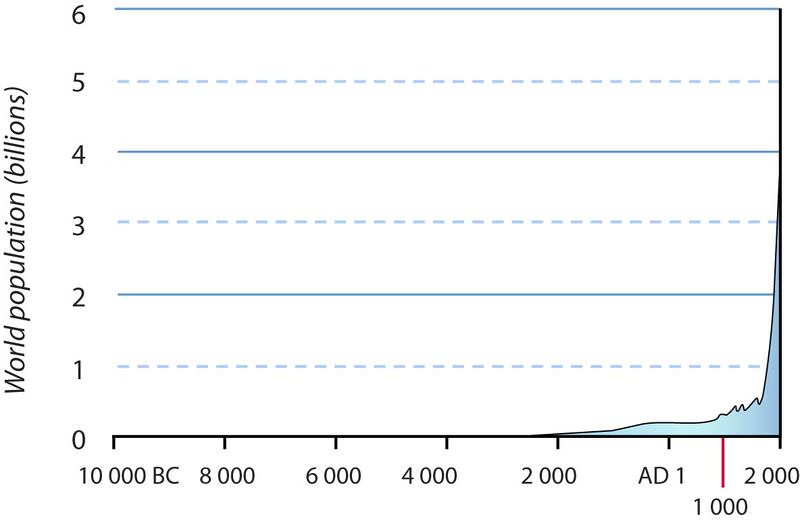17.11: Revolutions in Human Population
- Page ID
- 5971
Where on the graph are the major population changes?
Let's look at this graph again. It shows human population from 10,000 BC through 2000 AD. Where are the big changes in slope of the line? Can you identify them? In this concept, we'll learn what causes them.
What Causes Human Populations to Grow?
Look at the graph above. Human population increased dramatically at certain times. The graph begins 10,000 BC, although you can't really see the line. Population starts to rise perceptibly at around 1800 BC. The numbers begin to rise dramatically about 200 years ago. What causes these changes?
Agricultural Revolution
Farming was developed about 10,000 years ago. Farming meant a steady supply of food. People could settle in villages. The rise at around 1800 BC is due to increased farming and the rise of cities and towns. After 1800 AD, population shoots up dramatically. Really dramatically. What happened?
Industrial Revolution
The Industrial Revolution is what happened. The Industrial Revolution began in the late 1700s in Europe, North America, and a few other places. Before the Industrial Revolution, most labor was done by people. The Industrial Revolution changed the source of power from humans to fossil fuels. This allowed more work to be done and more food to be grown. People began to move into cities.
Where the Industrial Revolution was taking place, the human population started to grow really fast. The birth rate was always high. What changed was the death rate. The population grew because more people stayed alive. The death rate fell for several reasons:
- New farm machines were invented. They increased the amount of food that could be produced. With more food, people were healthier and could live longer.
- Steam engines and railroads were built. These machines could quickly carry food long distances. This made food shortages less likely.
- Sanitation was improved. Sewers were dug to carry away human wastes (Figure below). This helped reduce the spread of disease.
Digging a London sewer (1840s). Before 1800, human wastes were thrown into the streets of cities such as London. In the early 1800s, sewers were dug to carry away the wastes.
With better food and less chance of disease, the death rate fell. More children lived long enough to reach adulthood and have children of their own. As the death rate fell, the birth rate stayed high for awhile. This caused rapid population growth.
The Green Revolution
The most recent increase in the slope of the population line is because of another advance in agriculture. The Green Revolution began in the mid-1900s. The Green Revolution has allowed billions of people to be added to the population in the past few decades. New methods and products increased how much food could be grown. These advances include:
- Improving crops by selecting for certain genetic traits. The desired traits promote productivity. Recently, genetically engineered crops have been introduced.
- Increasing the use of artificial fertilizers and chemical pesticides.
- Increasing the use of agricultural machinery: plowing, tilling, fertilizing, picking, and transporting. These machines are powered by fossil fuels, rather than humans.
- Increasing access to water. Many rivers have been dammed. Wells tap into many groundwater aquifers.
The Green Revolution has increased the productivity of farms immensely. A century ago, a single farmer produced enough food for 2.5 people, but now a farmer can feed more than 130 people. The Green Revolution is credited for feeding 1 billion people that would not otherwise have been able to live.
The Health Revolution
Health care has been improving over the most recent centuries. Vaccines were developed that could prevent many diseases (Figure below). Antibiotics were discovered that could cure most infections caused by bacteria. Together, these two advances saved countless lives.
This child is getting a polio vaccine. She will never get sick with polio, which could save her life or keep her from becoming crippled.
Summary
- Farming allowed people to have a steady food source and settle down. The Green Revolution has dramatically increased agricultural productivity.
- The Industrial Revolution brought new machinery, increased the food supply, and improved sanitation.
- Vaccinations and antibiotics have greatly improved human health.
- With a dramatically lower death rate, human populations have grown.
Review
- What caused the first rise in human population?
- Why has the Industrial Revolution altered human population numbers?
- How has the Green Revolution increased agricultural productivity?
- If the birth rate doesn't change but the death rate goes down, what happens to population?
Explore More
Use the resources below to answer the questions that follow.
- Where did most people work in the late 1700s? Who did they work for?
- What did the new machines do?
- What became more affordable?
- Why did families move? Where did they move from and to?
- Who were the workers? Who did they work for?
- What problems did industrialization cause?
- Where were the worst conditions?
- Why were unions formed?




